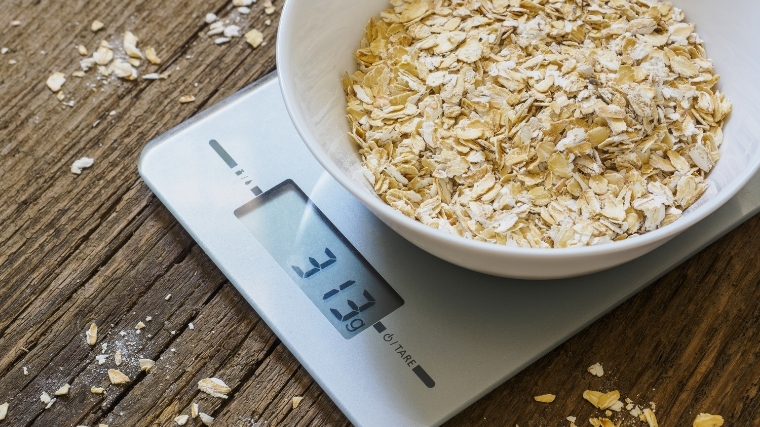Unless you’ve been consciously avoiding all fitness content for the past five years, you have probably heard someone talk about counting macros. You also possibly heard them mention how macro counting or If It Fits Your Macros (as it’s commonly called) enables you to eat donuts, chips, and even drink beer. “This can’t be true,” you’re thinking. Well, it is — but there’s a lot to learn about how to count macros before diving headfirst into a bag of Ruffles.
Folks sometimes refer to IIFYM as an anti-diet. That’s not true. Macro counting is absolutely a diet. What those people really should be saying is that macro counting isn’t a restrictive diet. Instead of banishing junk food from your eating plan, as some other diets may do, macro counting encourages you to work the foods you enjoy into your day of eating while still seeing results. By counting calories and tracking food, you’ll gain a better sense of how to intuitively eat for your goals over time. Here are the steps you need to take to track your macros successfully:
- Learn About IIFYM
- Establish Your Calories
- Set Protein Intake
- Set Fat Intake
- Set Carbohydrate Intake
- Get the Right Tools
- Make Better Food Choices
- Get Creative in the Kitchen
- Plan for Nights Out
- Adjust Your Macros as Needed
- Learn the Benefits of Counting Your Macros
- Set Yourself Up For Long-term Success
Editor’s note: The content on BarBend is meant to be informative in nature, but it should not be taken as medical advice. The opinions and articles on this site are not intended for use as diagnosis, prevention, and/or treatment of health problems. Consult with your doctor before undergoing a change in diet.
What is Macro Counting?
The word “macro” is short for the macronutrient. There are three macronutrients: protein, fats, and carbs (well, technically four if you count alcohol). All food is made up of macronutrients, so when someone says they are following a macro-based eating plan, they mean to say that they are counting their macros. Since all foods are made up of macros, every diet is technically macro-based. Each macro contains a set number of calories, and so you calculate your macro total based on your caloric intake. (More on that below.)

Your weight is dictated by how many calories you’re taking in and expending. Calories fuel the body. If we burn more calories than we eat, then we lose weight. If we burn fewer calories than we eat, then we gain weight. This is a bit of an oversimplification as the metabolism is a complex machine, but this basic calories-in-calories-out formula works.
Now, you can count calories and lose or gain weight. However, if you want to gain muscle and strength or lose fat, your specific macros need to be dialed in. That’s because each macronutrient has specific functions within the body.
Protein is the building block of the muscle and is responsible for muscle gain (if you’re in a caloric surplus) or muscle retention (if you’re in a caloric deficit). Fat is necessary for hormonal functions, particularly sexual hormonal function (so, yeah, it’s pretty important). Carbohydrates are technically a non-essential macro, meaning you don’t need it to function, but our bodies convert carbs to glucose for energy. If you lift weights or play a sport, you will most likely want carbs in your diet to help you perform. Especially when you consider that research in the journal Nutrition Today refers to carbohydrates as “an indispensable energy source for high-intensity performance.” (1)
How to Calculate Your Macros
To create a macro-counting plan, you need to establish a hierarchy of macro importance. Calories are at the top since your overall caloric intake dictates which whether you gain or lose weight. Think of calories as a corporation and your macros as the divisions of labor. You’ll set your overall calorie total depending on your goals and then divide that number into your macronutrients. Follow these steps to set up your macro plan.
[Related: A Powerlifter’s Take on the If It Fits Your Macros (IIFYM) Diet]
Establish Your Calories
Your overall activity level will dictate your total caloric intake. From there, you’ll divide your calories into your macros. Most people are moderately sedentary. Even if you do CrossFit five-times per week — those five hours of weekly activity don’t make up for the other 163 hours you spend sitting at your desk, surfing Instagram on your couch, and sleeping. Unless you work a labor-intensive job (like construction), the calculations below, based on moderate activity levels, will work fine for you.
Here’s how to find your total calories:
- For fat loss, multiply your body weight by 11. If you’re a 200-pound man, then your starting point will be 2,200 calories.
- For muscle gain, multiply your body weight by 15 to start. If you have trouble gaining weight, you can multiply your calories by 18 (or even 20 in some cases). Remember, there’s no magic formula — finding the right number takes trial and error.
Set Your Protein Intake
If you eat too little protein, you risk losing muscle in a caloric deficit or not gaining muscle in a surplus. Neither option is ideal. Generally, you want to consume one gram of protein per pound of bodyweight. So a 200-pound man eating 2,200 calories (this is the example we’re sticking with throughout the article) will eat 200 grams of protein.
There are four calories in a gram of protein. To figure out how many calories from protein you’re eating, multiply your protein number by four. In this instance, the 200-pound man is eating 800 calories worth of protein. You’ll need to know this number to calculate your complete macros.
Set Your Fat Intake
Fat is essential, but it’s also calorically dense and usually not as satiating as the other two macros. One gram of fat yields nine calories, or more than double what protein and carbs contain. Beacuse of its caloric density, fat is the macronutrient you’ll eat the least. Fats are usually found in eggs, dairy, nuts (and nut butters), and certain fatty meats (like bacon). These foods taste great, but foods high in fat are usually not as filling compared to foods higher in carbs or protein.
As an example, to consume 28 grams of protein you can either eat four-and-half-ounces of chicken breast or four ounces of peanuts. The peanuts also contain 52 grams, 24 grams of carbs, and 640 calories. Or, for the 200-pound man, about a third of his daily calories. On the other hand, the chicken deliversthe same amout of protein — but with two grams of fat, zero carbs, and 135 calories.
To calculate your fat, multiply your body weight by 0.30 – 0.35. The 200-pound man’s fat intake came out to be 60 grams.
Set Your Carbohydrate intake
You’ll calculate your carbohydrates last. For the man to find this number, he’ll multiply his 60 grams of fat by nine (the number of calories per gram of fat) to get 540 calories. He’ll then add that to his 800 calories (from protein) to equal 1,340 calories that are already accounted for. Then, he’ll subtract that nubmer from his caloric goal of 2,200 This leaves 860 calories. Divide that number by four (the number of calories in a gram of carbs), and you end up with 215 grams of carbohydrates. His total macros are 2,200 calories, 200 grams of protein, 215 grams of carbs, and 60 grams of fat.
If your math is a little rusty, you can use BarBend’s macronutrient calculator to find your starting macros. Remember to be honest about your activity level.
Macronutrient Calculator
How to Successfully Track Your Macros
Now, you’re ready to track. It’s fairly simple. To do so, you need the right tools and a little know-how, which we’ll go over in this section.
Get the Right Tools
Keeping track of your macros isn’t hard, especially in the year 2020, when there are all sorts of apps (most of them free). Back in the day, bodybuilders would write down their calories and macros with a pen and paper (imagine that?).

The first thing you will want to do is download a nutrition tracker to your smartphone. The most popular option is MyFitnessPal. It has a pretty extensive food database and is compatible with popular fitness trackers. The one downside is that the app is oversaturated. There are many food entries to choose from, but a lot of them are incorrectly entered. Chronometer isn’t as compatible with other devices, but it offers more accurate food entries.
Next, get a food scale. You can get a perfectly fine scale on Amazon for anywhere from $10 to $20. Don’t invest in anything too nuts; you don’t need a bunch of bells and whistles. You’ll use a food scale to measure out your protein, carbs, and fats. It’s far more accurate than using measuring cups. Don’t believe it? If and when you get a food scale, weigh out what you believe to be a tablespoon of peanut butter (then shed a tear over how small an actual serving is).
Then, you’ll buy a digital scale. You need a bodyweight scale to measure your weight progressions (or regressions). Otherwise, you won’t have any idea if your macros are helping you lose, gain, or maintain your weight. Again, there’s no need to buy anything fancy. Though, some folks like scales that measure their bodyfat level and/or can link to MyFitnessPal.
These are the essentials. Other gadgets such as an air fryer, instant pot, or sous vide can help you cook up deliciously healthy and macro-friendly food, but they’re not a must for success. Stick with macro counting for a bit, and then invest in these luxury items over time. They are nice to have.
Choose the Right Foods
The siren song of macro counting is that you can eat whatever you want. While this is technically true, there are some stipulations. For this diet to work, you need to hit your macros. Many of the foods you’re probably eager to eat are also high in fat and carbs. For example, a Big Mac from McDonald’s packs 550 calories, 25 grams of protein, 45 grams of carbs, and 30 grams of fat. That’s half of the 200-pound man’s fat allotment for the entire day. The caveat is if you want a Big Mac, you can have it, but then you need to fulfill your now-lopsided macros. That means you’ll be eating a lot of chicken, rice, and veggies for the rest of the day.

There’s nothing wrong with this approach, but it’s not sustainable for most people. A Big Mac isn’t even that filling, so you’re losing 30 grams of fat that you can divvy up among multiple portions of lean steak, beef, or other meats.
Typically, you’re better off sticking to the typical array of healthy whole foods. Mainly because these whole foods — think lean meats, grains, and fats such as avocados — are single-macro foods. This means these foods contain predominately one macro. Single-macro foods are easier to mix and match and plan with, bringing us to the next point.
Get Creative in the Kitchen
Are you hankering for a Big Mac since reading the paragraphs above? Make your own! Seriously. Go to the grocery store, pick up hamburger buns, low-fat cheese, mustard, and extra lean beef. Cook the meat up as you would any burger, place it on the buns and then top with veggies like lettuce, tomatoes, onion, and pickles. While the numbers vary based on the brands of food you buy, the Big Mac replacement’s estimated macros are 330 calories, 36 grams of protein, 22 grams of carbs, and 10 grams of fat (using four ounces of 96% lean beef).
You can make healthy swaps with all sorts of your favorite foods. Whip-up pizza using naan bread instead of dough and top with low-fat mozzarella and turkey pepperoni; make a hoagie with lean meats and plenty of veggies; or recreate a bacon, egg, and cheese sandwich with turkey bacon and egg whites. The goal is to craft meals that you love, but with a better balance of protein, carbs, and fats.
Plan for Nights Out
Of course, you’re going to have nights when you want to drink some beer (or soda, whatever your poison is) and eat junk — real, tasty, saliva-inducing junk that won’t ever fit responsibly into your macros. It’s going to happen. The best way to mitigate the damage is to plan. If you know ahead of time that you’re going out to dinner with friends, prioritize protein and eat fewer grams of carbs and fats during the day. This way, you have some caloric padding.
A few drinks and one off-plan meal won’t derail your progress, but don’t keep on slipping. It is not hard to drink and eat 3,000 (or even more) calories in a night. And if that happens too often, then your weekly caloric deficit will become a surplus. Your best bet is to work treats into your daily macros to keep cravings to a minimum. If you’re mostly sticking to your plan, however, then a night out here and there won’t hurt. After all, the point of macro-counting is to make your diet work for your life, not let your diet dictate your life.
Adjust Your Macros as Needed
Track your macros for two weeks and then check your weight (in the morning, after you’ve used the restroom). If your goal is to lose weight and you haven’t, then reduce your intake by 100 calories from carbs (if you’re a smaller-framed person) or 200 calories (if you’re larger). This equats to 25 to 50 extra grams of carbs. If you want to gain and lose weight, or the scale stays the same, add either 100 or 200 calories worth of carbs. Then, check your weight each week (at the same time each time) and keep on adjusting.
The Benefits of Counting Your Macros
Counting macros helps you understand how many calories and grams of macros are in food. Whereas you wouldn’t have thought twice about digging into a sundae, soon you’ll analyze its caloric density. That sounds lame, but you’ll become more aware of your food choices — which is a good thing.

Counting your macros versus following a fad diet is similar to the proverb, “Give a man a fish, and you feed him for a day. Teach a man to fish, and you feed him for a lifetime.” Fad diets may get you the results, but you won’t understand why or how it worked. On the other hand, macro counting gives you the formula that all diets use (in one form or another) and leaves it up to you to make your own food choices. Not only will you make progress, but you’ll become informed as to why and how you got those results. This will enable you to adjust your diet in the future as necessary and make food swaps without the fear of blowing up your progress. Counting your macros is empowering.
How to Succeed in the Long Run
It’s not feasible to track your food forever. That’s not the point of macro counting either. These numbers are just a starting point. They’re a guideline to get you going. Counting your macros is simply a strategy to increase your awareness around food and help you develop healthier habits. We know that all diets work, and all diets fail. Success really depends on adherence. So how can we become more adherent?
The best way to succeed is to control your environment. Most of us live in an environment that controls us. Many people are reactive, emotional, and unprepared for what lies ahead. Creating a food template is one way to start being proactive in controlling the obesogenic food environment you live in.
Prepare Food Ahead of Time
Start by making the hard things easy. Preparing your food ahead of time is a good start. This doesn’t mean you have to stock your refrigerator with rows of Tupperware. What it does mean is that you should have some go-to items ready. Protein is typically the most time-consuming food to prepare. Try batch-cooking chicken breast, which you can eat with rice, toss into a burrito, or use in a sandwich. Or, keeps snacks such as greek yogurt, protein powder, and beef jerky on hand. If you have those options at home, you’re far less likely to browse Grubhub.
You can also stock up on frozen veggies to save cooking time. If you’re very busy, invest in some macro-friendly frozen meals. Nowadays, there are plenty of healthy and balanced frozen food options.
Eat Out Less
This isn’t to say you can never eat out, but restaurant meals are most likely fattier than what you’d cook at home and serve up less protein. If you are eating out, check the menu beforehand to identify the best option for your macros. This way, you’ll feel prepared and avoid making an impulsive, last-minute decision. Most restaurants will also be happy to serve you grilled chicken, veggies, and rice or potatoes.
Realize IIFYM Isn’t a Magic Bullet
Macro counting is simply a way to improve awareness and organization around food. It isn’t for everyone and probably shouldn’t be something you rely on forever. If you like to count stuff every day, cool. But if not, you should be able to eat more intuitively when it is time to maintain. You don’t want to fall back into bad habits once you’ve reached your goal weight — and for most people, tracking your macros sets you up for long-term success.
References
- Kanter M. High-Quality Carbohydrates and Physical Performance: Expert Panel Report. Nutr Today. 2018;53(1):35-39. doi:10.1097/NT.0000000000000238
Featured Image: Dragon Images/Shutterstock